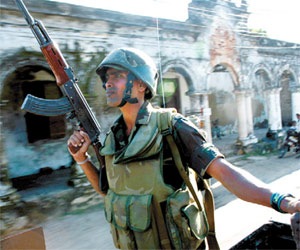 When the Sri Lankan government under the newly elected President Mahinda Rajapaksa decided to fight the Liberation Tigers of Tamil Eelam (LTTE) to the finish in 2006, the optimists were in a miserable minority.
When the Sri Lankan government under the newly elected President Mahinda Rajapaksa decided to fight the Liberation Tigers of Tamil Eelam (LTTE) to the finish in 2006, the optimists were in a miserable minority.
Under the crafty and mysterious Velupillai Prabhakaran, the LTTE was almost universally believed to be invincible. Between 1987 and March 1990, it had survived the formidable onslaught of the Indian Peace Keeping Force (IPKF) officered by battle-hardened veterans of the 1965 and 1971 wars against Pakistan. In the 1990s, through three operations entitled “Unceasing Waves” it had driven the Lankan army out of the vast Wanni region, besides retaining its hold on the Eastern province.
By the end of the 1990s, the LTTE had acquired 122 and 155 mm artillery, built up a navy of fast boats called Sea Tigers, and a fleet of more than 10 ocean going vessels for gun running. By the time Rajapaksa came to power in 2005, the Tigers had a fledgling air force comprising a few Z-143 aircraft which staged a couple of nocturnal raids on Colombo in the 2006-2009 Eelam War IV.
“The LTTE was not a small group battling a giant as many people imagined. Over 30 years it had killed more than 26,000 Sri Lankan military personnel besides innumerable civilians including a President of Sri Lanka and a former Prime Minister of India,” said the Lankan Defence Secretary, Gotabaya Rajapaksa, in his keynote address at the international conference on “Defeating Terrorism: The Sri Lankan Experience” in Colombo on May 31.
Limited attacks on specific targets was key strategy
The “realists”, not all of whom were acolytes of the LTTE, believed that the LTTE enjoyed the tacit and overt support of the 60 million Tamils in Tamil Nadu and that New Delhi would willy nilly go along with the sentiments of Tamil Nadu.
Rajapaksa’s Thinking
President Mahinda Rajapaksa and his brother and Defence Secretary Gotabaya firmly believed that the LTTE could be defeated, if the right military and political steps were taken and adhered to steadfastly. Gotabaya, himself a retired Lt Colonel, believed that the Lankan armed forces had always been good and had won many battles, but there had been deficiencies in organisation, strategy, tactics and leadership which could not exploit the innate capabilities of the men in uniform.
Under the generalship of the currently disgraced Sarath Fonseka, the army gave up the policy of taking territory for territory’s sake and then trying to hold on through a static network.
War of Attrition
Fonseka’s new doctrine was to search and destroy LTTE’s manpower and assets debilitating the LTTE’s capability over time, making it recruit civilians forcibly, thus alienating its main support base, the Tamil population. The army’s long range commando units also targeted LTTE leaders.
Role of Small Units
Majors General Chagi Gallage, Jagath Dias and Prasanna de Silva said that large infantry formations, long range area weapons and air strikes played a big role in decimating the LTTE. But victory would have impossible without the Special Forces, the commando units and other small groups drawn from the infantry divisions. Small groups, comprising eight to ten men, breached the LTTE’s defenses; infiltrated its lines, and attacked from the rear, totally disorienting its cadre. From behind the enemy lines these small groups provided valuable intelligence to the main infantry formations.
Field Level Autonomy
All field units, down to the small groups, were given the power to determine strategy and tactics, based on the ground situation and battlefield intelligence. These decisions were immediately communicated to the higher levels through a good communications system.
(For updates you can share with your friends, follow TNN on Facebook and Twitter )
